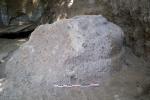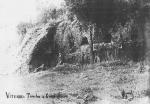Summary (English)
The rock-cut tomb of Grotte Scalina is situated in a solitary position in the countryside midway between Viterbo and Tuscania. At the time it was created, towards the end of the 4th century B.C., this area corresponded with the central part of Tarquinia’s territory, occupied by a network of fortresses, which included the inland colony of Musarna, only 2 km to the south-west. This is the first season of a joint research and excavation project run by il CNRS (UMR 8536, ENS, Paris), the Archaeological Superintendency for south Etruria and the École française de Rome. This is an exceptional tomb, known from early 20th century documents, but all traces of which were lost. Considered to have been destroyed, it was rediscovered in 1998 during the survey around the site of Musarna.
The monumental facade, c. 15 m wide, has partly collapsed. Its first level is c. 6 m high to the rear of which the cut tufa presents a false door, to the west of which steps lead up to the monuments first floor. The work undertaken in 2011 showed that the drawing made by L. Rossi Danielli was not correct: it indicated the presence, below the facade, of an underground chamber (with 2 m sides), containing a single bed, at about 2 m below ground level. In effect, the entire length of the dromos was exposed and the excavation of its front part made it possible to calculate the tomb’s depth, which should be about 7.50 m. The chamber is square in plan with a central pillar. According to local sources, is still thought to contain about ten sarcophagi with reclining figures. Investigation in front of the facade uncovered, to the east, a column base with moulding and traces of stucco that is almost 2 m in diameter, and ascertained the presence of a second symmetrical column to the west. The excavation also uncovered a second dromos, perpendicular to the tomb’s main dromos, according to a plan attested in other monumental tombs of contemporary date.
These first elements have shown that this tomb, to date considered to be an isolated type, was in reality very similar to one of the known larger Hellenistic rock-cut tombs, the Lattanzi tomb at Norchia. The proportions, general plan, architecture and probably the date, are the same. The evidence seems to suggest that both monuments were built by the same team of specialist artisans.
- Vincent Jolivet - CNRS
- Edwige Lovergne - Università di Paris I
Director
Team
Research Body
- CNRS
- ENS
- École Française de Rome






![Download [PDF]](/excavation/skins/fasti/images/results/download_sml.png)

